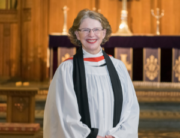A sermon given during the 6:00pm Choral Evensong, by The Rev’d Joan Claring-Bould, on the 16th April 2023.
“He is not here; He is Risen” (Mk 16:6)
Very early on the first day of the week, Mary Magdelene, Mary the mother of James and Salome went to the tomb, with spices to anoint the body of Jesus. We can only imagine the grief they had been experiencing since the earth-shattering death of Jesus just days ago. It was their first opportunity to get to his tomb to anoint his body with spices for his funeral.
At least some of us will have had the experience of setting out to do something at time of grief, or when we have felt a strong spiritual leading to do so, when in normal circumstances the challenges preventing us to do so would seem too great. And somehow the threatening obstacles are overcome. Then when we reflect on it we call it a miracle!
On this day the three women were only intent on getting to the tomb to anoint the body of Jesus. They talked about the huge stone in front of the tomb and who would roll it away, but we can be assured that they knew they couldn’t do it themselves.
When they arrived and looked up from their discussions, they saw that the very large stone had already been laid back, and inside was a young man dressed in white. (That miracle had happened!)
Understandably they were alarmed. But the young man said to them, “Don’t be alarmed, you are looking for Jesus of Nazareth,.. He is not here, He is Risen – Look there is the place they laid him” (Mk 16:6)
Then the young man told the women to go to tell his disciples and Peter that Jesus was going ahead of them to Galilee, where they will see him. But the women were filled with terror and amazement and said nothing to anyone for they were afraid.
All four gospels mention the empty tomb (Matthew 28:1–6; Mark 16:1–7; Luke 24:1–12; John 20:1–12), which testifies to its importance to the early Church. In St. John’s gospel it was Mary Magdelene (who is mentioned in each gospel) alone, who got to the entrance of the tomb then raced off to tell the disciples. Each gospel writer recounts the story in a slightly different manner, but in every case the first people at the tomb were women.
So the Gospels report that, while Jesus’ male disciples were cowering in fear, hiding from the authorities, it was women who were the earliest witnesses of the empty tomb. There would simply be no reason for the early church to make up such a scenario unless it was true. Why would the early Christians portray their male leadership as cowards and place females in the role of primary witnesses?
The principal witness to the resurrection, (Mary Magdalene) was said to have been possessed of seven devils earlier in her life, thus making her potentially an even less reliable witness in the eyes of many. And yet, despite this handicap, the earliest Christians insisted that the first witnesses to the empty tomb were, in fact, women, and the earliest Christians were unwilling to lie about it despite its potentially embarrassing nature.
But it was not only Mary Magdelene who might have been seen to be an unworthy witness. It is no coincidence that the young man says to the women “Go and tell the disciples and Peter that he is going ahead of you to Galilee” (Mk 16:7)
Why his disciples and Peter?
Well, at a time when the disciples would have been overcome with grief and fear, we remember that Peter was carrying the extra burden of guilt and grief which came crashing down on him when the cock crowed three times. He had denied his Lord, and left him to be crucified.
This was the first sign that Peter could be forgiven and restored to his former role amongst the disciples.
The three women who set out so early to get to the tomb to anoint the body of Jesus, despite the huge stone which was in front of it, after entering the tomb and encountering the young man robed in white who told them that Jesus was no longer there but had risen, were told to go and tell the disciples where they would find him.
But we are told, they were amazed and terrified, and said nothing to anyone for they were afraid!
The women are presented in Mark’s gospel as model disciples. They had stayed with Jesus as he died after the men had fled. They were there to prepare his body for burial, and it was the women who were the first missionaries of the Risen Christ (16:7). But this encounter was too much for them. They had run away.
No one is perfect. The disciples were not perfect. Those who loved Jesus were not perfect. We are not perfect. The Church is not perfect.
Mark is encouraging his community, not to give up, even when they have run away, and the same is true for us. He wants to remind us that when the first disciples failed him, Jesus remained faithful to them, and when we fail him, Jesus remains faithful to us.
In our own lives we all experience failure and loss; small deaths that occur in our everyday living, and as circumstances change in our lives, within our families, within our work places, with our physical and mental capabilities even at times chances in our church community. All these things can mean loss and grief of leaving things or situations which were familiar to us and brought us comfort, and which have been God-given in their time. These changes cause us to mourn but we know we must move on. And each time we do we are reminded that we are not alone, that as Fr. Henri Nouwen puts it, “your mourning, too, can be turned into dancing, even if it is a gentle and slow dance.” And the dance leads us to the larger life to which we are ultimately called.
On the cross Jesus bore the weight of our sin for all time. The arms of Jesus stretched out on the cross, have become for us the arms of forgiveness, healing and welcome. He who has died is risen. None of us ever needs to hide from the loving and compassionate gaze of our crucified and risen Lord.
That is the Easter Promise
What keeps hope alive is the cultivation of gratitude; a thankful heart.
The Risen Lord says to us, “Do not be afraid, I am with you.” The fear and joy that surround the resurrection speaks to us all. Hope is kept alive by the cultivation of gratitude, a thankful heart.
Be not afraid, sing out for joy, Christ is risen Alleluia





